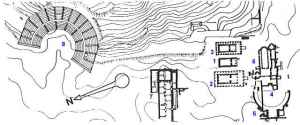|
|
|
|
|
|
|
 |
Plan of Letoon
The Apollo temple on the eastern side of the precinct is in the Doric order and in a rather poor state of preservation. It is somewhat smaller than the Leto temple, measuring 27.90 by 15.07 meters. It too is in the peripteros style and has six by eleven columns. It was built during the Hellenistic period. The temple has a deep pronaos and opisthodomos and within the cella there is a mosaic in which Artemis's bow and quiver and Apollo's lyre are depicted. In the vicinity of the temple was found an inscription of great importance whose text is repeated in Greek, Lycian, and Aramaic. The inscription is from the reign of Artaxerxes III and is dated to June of 358 BC. It makes reference to one Basileos, the legendary founder of Kaunos. This inscription has played a vital role in the deciphering of the Lycian language.
On the southwestern side of the terrace on which these three temples are located is a lovely monumental fountain called a nymphaeum. This semi-circular portico contains a basin measuring 27 meters in diameter. Inscriptions found in situ indicated that the fountain was built during the reign of Emperor Hadrian (117-138).
South of the temples are a monastery and a church that date to the 4th century. Both suffered destruction around the middle of the 7th century. North of the temples are the remains of Hellenistic and Roman porticoes in the Ionic and Doric orders. The site also contains structures dated to the 4th century BC. and finely-wrought walls from the Lycian period. North of Letoon, about a hundred meters from the temple on the hillside, is a Roman period theater. The skene (stage building) can no longer be made out and only the cavea (auditorium) remains. The cavea is divided into two by a single diazoma (horizontal passage). An enclosed passageway on either side provides access to the auditorium. The southwest corridor is decorated with a frieze of theatrical masks.
|
|
| |
|
Our Hotel | Turkey | Cappadocia | Daily Tours | Views | Guestbook | Request Form | Home |
|